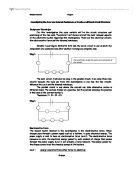V=E-ΔV=E-Ir
The internal resistance of a source of e.m.f. limits he power that can be supplied to an external circuit. A source of e.m.f. connected to an external circuit will dissipate some of its energy in its internal resistance, and transfer the rest to the external circuit. It is often desirable to transfer as much electrical power as possible from a source to a load, for example when an aerial is connected to a television. Investigations show that in order to do this, the resistance of the load must be equal to the internal resistance of the source, since the power supplied by a source to a load varies.
On the graph above, when a source of e.m.f. delivers power to a load (resistance), there is a value of R for which the maximum power is transferred, as the graph shows. Calculation shows that this value is equal to r, the internal resistance of the source of e.m.f. So to calculate the internal resistance from this graph, we have to look at the maximum point on the line, which is 0.18W and the internal resistance for that is 23 ohms.
Consider a source of e.m.f. E with an internal resistance r, delivering a current I into a load resistance R.
The current I is given by:
I=E/R + r
The power P dissipated in the load is given by:
P=I2R=(E/R + r)2R
For a given internal resistance r, there will be a particular load resistance R for which the power dissipated in the load has a maximum value. To find this it is necessary to set up a differential equation:
dP/dR = E2d/dR[R/(R + r)2]
Differentiating the expression in the square brackets with respect to R gives the expression:
d/P/dR = E2[(R + r)2 – 2R(R + r)/(R + r)4]
= E2[r – R/(R + r)3]
Noting from the graph that the maximum value of P occurs where dP/dR = 0, we can set this expression equal to zero. dP/dR = 0 when r – R = 0, that is, when R = r. Therefore the condition for matching source and load is that the resistance of the load must be equal to the internal resistance of the source.
Electromotive force (e.m.f.) is the difference in electric potential, or voltage, between the terminals of a source of electricity, e.g., a battery from which no current is being drawn. When current is drawn, the potential difference drops below the e.m.f. value. Electromotive force is usually measured in volts.
To work out the electromotive force, we need to look at the current against voltage graph and look at the line and carry it on until it cuts the x-axes, which represent the voltage. So we estimate it at 3.3 volts.







